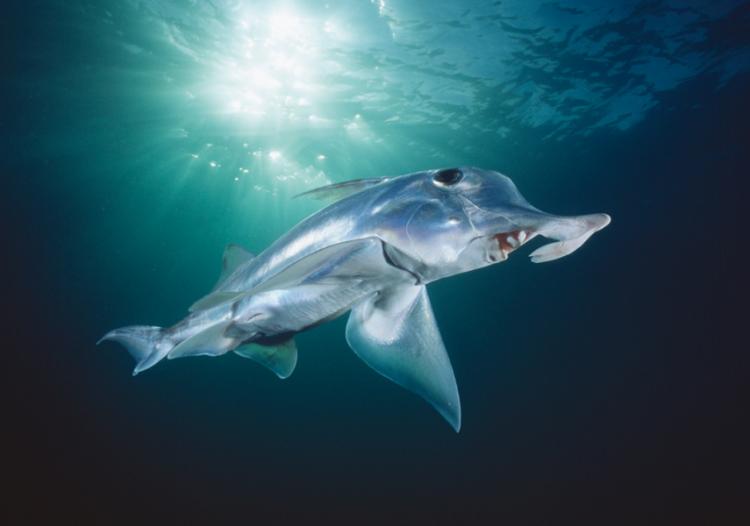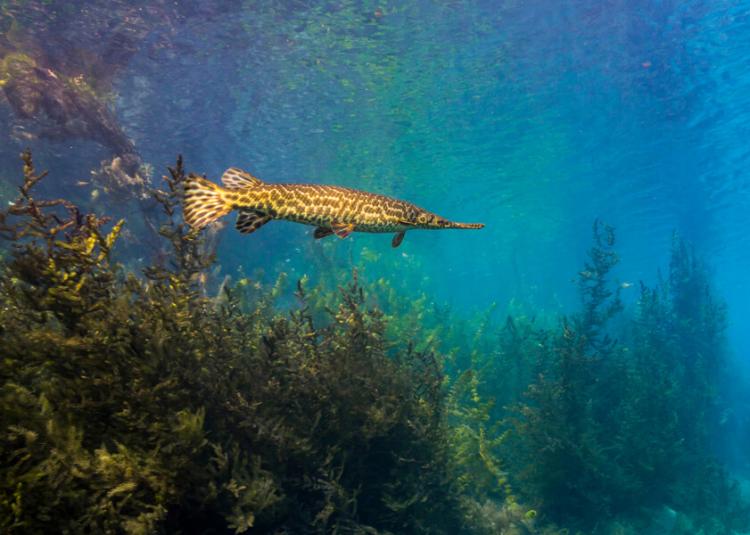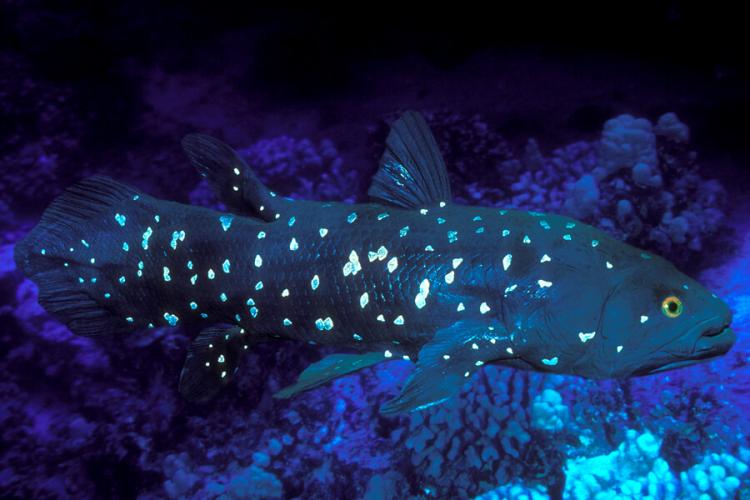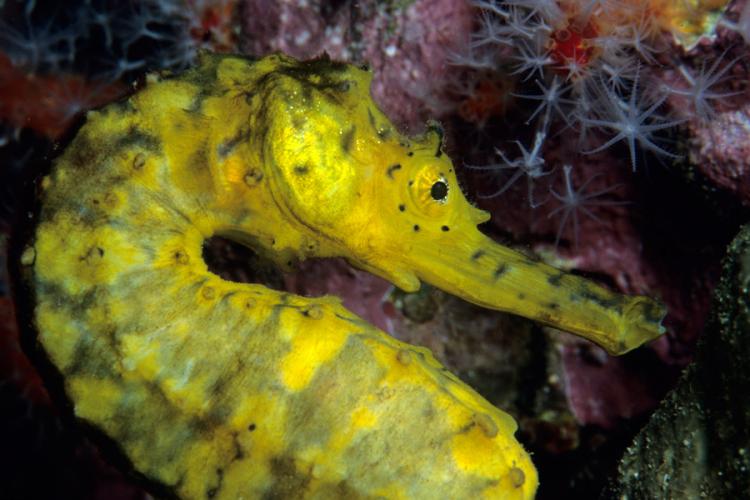It has been called “the world’s most dangerous meal,” a fish whose internal organs are laced with one of the deadliest toxins on Earth. Specialized restaurants in Japan and a few other places serve carefully prepared fugu flesh as an expensive delicacy, in part because of this risky thrill.
But Byrappa Venkatesh was drawn to the fugu for an entirely different reason: It has the smallest genome of any vertebrate. That quality was gold back in the 1990s, when geneticists were still racing to sequence the human genome or that of any other vertebrate: Fugu offered a shortcut to the finish line. The puffer was still a slog, though. It cost Venkatesh and his colleagues nine years of hard work and about $10 million, and, in the end, the human genome project nosed them out, just barely, as the first vertebrate genome ever completed.

The puffer fish Fugu rubripes has the smallest genome of any vertebrate. It was the first fish species selected for genome sequencing.
CREDIT: BYRAPPA VENKATESH
The project kindled a passion for fish genomics that has propelled Venkatesh ever since. With good reason: Fish are the most diverse group of vertebrates on the planet. They live in deep ocean, in acid waters and in Antarctic seas below the freezing point of blood. Their bodies range from eely, jawless lampreys to flattened flounders to huge, lumpish ocean sunfish. Some lay eggs, some bear live young, and in seahorses, it is the males that become pregnant. In short, fish are a geneticist’s dream. “They show so many variations,” says Venkatesh. “If there is any adaptation in any vertebrate, it should be there in fish.”
In the years since completing the fugu genome in 2002, Venkatesh — known universally as Venki — has sequenced the genomes of more than a dozen fishes, from sharks to the living-fossil coelacanth to his personal favorite, the seahorse. “He’s been a champion, in a very mild-mannered but persistent way, for a long time,” says Richard Durbin, a genomicist at the University of Cambridge. “He’s one of the focal persons for evolutionary fish genomics.”
Venkatesh has seen an enormous growth in sequencing power and technology since the early days of fugu. Today, generating a high-quality genome sequence from scratch takes just two months’ work and about $30,000. “Nobody predicted it would happen so fast,” he says. “You can sequence any genome now.”
And you can sequence lots of them. Venkatesh, based at Singapore’s Institute of Molecular and Cell Biology, helps lead a consortium with big ambitions to sequence hundreds of vertebrate genomes by the end of this decade, nearly half of them fish, en route to eventually completing sequences of every living vertebrate, and more.
A student takes the bait
Despite his current prominence in genomics, Venkatesh came to the field almost by accident. Born in Bangalore, India, to a scientific family — his father was a veterinarian — he chose to study fisheries in university because it sounded like fun. “I thought I could go diving and have a great time,” he recalls.
He never did learn to dive. Instead, after a few years as a fisheries biologist in India, he headed off to Singapore for graduate school, where he studied the hormonal regulation of pregnancy in guppies.

The ocean sunfish (Mola mola) has a strange, truncated back end. It also is the largest bony fish species in the world, with some adults weighing in at more than 2,000 pounds. Analysis of the sunfish genome reveals features that may explain its rapid growth rate and impressive size.
CREDIT: CULTURA CREATIVE / ALAMY STOCK PHOTO
While there, he met Sydney Brenner of the University of Cambridge, one of the founders of molecular biology. Brenner wanted to be first to sequence a complete vertebrate genome and selected fugu for its tiny genome. He was looking for scientists to work with him on the project and saw something special in Venkatesh. “He said I should go join him in Cambridge,” says Venkatesh. “I had very little molecular biology background at that time, but he said it would be good for me.” Off he went to Cambridge, as the only fish expert on Brenner’s team.
In 1992, after Brenner left Cambridge for California, Venkatesh returned to Singapore to take up a job at the institute, bringing the fugu genome project with him. (Eventually Brenner, too, moved to Singapore, where he established his own lab next door to his protege’s. Now age 91, he still lives in Singapore and the two meet weekly for a drink or dinner.)
The fugu genome gave geneticists a valuable point of comparison to the human genome. They found that, despite its small size — just one-eighth the size of the human genome — the fugu has roughly the same complement of genes, and the on-off switches that control them, as humans do. To reach its slimline state, fugu seems to have lost many of the long, baffling stretches of DNA of unknown function — often called junk DNA — that litter most genomes. That made the fugu genome a helpful tool for separating the human genomic wheat from the chaff and especially for identifying the crucial regulatory switches, says Venkatesh. He later showed that the fugu’s regulatory switches are so similar to their mammalian counterparts that they can sometimes be swapped without loss of function.
Dipping into the shark tank
Fresh from that success, Venkatesh turned his attention to other fish genomes. His first goal was to sequence a shark. Sharks lack bony skeletons, which indicates that they are an early branch in the evolutionary tree of vertebrates. Comparing their genes with those of bony fishes can thus shed new light on the evolution of higher fishes and their descendants, including humans.
But Venkatesh faced a big problem. Most sharks have huge genomes, far larger than those of humans, so they were difficult to sequence with the technology of the day. After two years of rummaging through the genomes of various shark species, he stumbled on the solution: the elephant shark, whose genome is only about a third the size of our own. “It’s the fugu among the sharks,” he says. That one, he could handle.

The elephant shark, Callorhinchus milii, is a genetic standout in two ways: Its genome is far smaller than that of most sharks and has changed far less over time than those of other vertebrates.
CREDIT: ASSOCIATED PRESS
The sequencing, completed in 2007, revealed that the elephant shark is a living genomic fossil — it has changed less from its ancestral state than any other vertebrate known. “It’s like a screen shot of the past, how our ancestors looked,” says Venkatesh. “That makes it a very useful model for examining what changes have occurred.”
More genomes followed quickly, including those of the deep-sea coelacanth (one of the closest living relatives of terrestrial vertebrates) in 2013, the spotted gar (a primitive bony fish) in 2015, and the gigantic ocean sunfish and the distinctively shaped seahorse in 2016. Other research groups joined the hunt, so that by early 2018, Venkatesh could list 60 bony fish genomes completed by various labs around the world.

The genome of the spotted gar (Lepisosteus oculatus), a primitive bony fish, offers insights into the evolution of vertebrate development, gene control, immunity and tissue mineralization.
CREDIT: STOCKTREK IMAGES, INC. / ALAMY STOCK PHOTO
At the molecular level, fish turn out to be much more diverse than land vertebrates. Some time early in their evolution, bony fishes underwent a duplication of their entire genome. This freed up “spare” copies of genes for evolutionary tinkering without risking loss of the original gene function. This may explain why bony fish genomes have evolved more rapidly than those of their terrestrial cousins.
The big catch
Though Venkatesh finds fish fascinating in their own right, there is a larger prize in play as well. Humans and fish share most of the same molecular building blocks — their complement of genes — but deploy them in different ways. “You can take a pile of bricks and make a cathedral, you can make a bridge, you can make a villa, or you can make a road. The question is, what are the controlling mechanisms that take those bricks and make them into what you can see? That’s the big question,” says Edward Wiley, an ichthyologist at the University of Kansas. Because fish vary so much in body form, they make an ideal test bed to work out many of those controls, with big potential payoffs for our understanding of all vertebrates, including humans.
These and other genome studies are now coalescing into a systematic effort to sequence the greatest possible diversity of vertebrate life. Venkatesh is one of the leaders of this consortium, known as Genome 10K, and is playing a key role in identifying which fish to include. “Venki has been in on fish genomics since the beginning. When G10K was formed, it was natural that they would ask him to be responsible for the fishes,” says Wiley who, with Venkatesh, cochairs the effort’s fish section.
As its name suggests, G10K began with the goal of sequencing 10,000 vertebrate genomes, mostly in a rudimentary fashion. Since then, though, the group has refocused on quality over quantity: sequencing at least one genome from every major group, or order, of vertebrates — some 260 in all — using the newest, high-precision sequencing technology. The first hundred genomes should roll off the line within the next year, and the full set of 260 should be done by 2020, says Erich Jarvis, a genomic neurobiologist at Rockefeller University in New York City, who chairs the project. After that, the group has an even more ambitious goal: to sequence the genomes of every one of the 60,000-plus vertebrate species.

The African coelacanth, Latimeria chalumnae, is from a lineage that was thought to have gone extinct 70 million years ago until a living specimen was discovered in the 1930s. The lineage is closely related to ancestral fish that gave rise to four-legged vertebrates.
CREDIT: WATERFRAME / ALAMY STOCK PHOTO
The technology is advancing so fast that a few genome biologists are talking of the ultimate goal: sequencing the genome of every species on Earth. The plan is not as far-fetched as it sounds. “There are something on the order of a million-and-a-half named species,” says Durbin. “We’ve probably sequenced on the order of a thousand. So there’s a thousandfold improvement to make. Typically, sequencing technologies are improving twofold a year. On that scale, in the next decade we’re going to be able to find the genomes of everything.”
If geneticists get anywhere close to that goal, current methods of sorting, comparing and understanding genomes will not cope with the enormous mass of data, says Gene Myers, a bioinformatician at the Max Planck Institute for Molecular Cell Biology and Genetics in Dresden, Germany. But Myers is optimistic that researchers, in time, will solve that problem, just as they learned to handle the once-daunting data management challenge posed by the human genome. “Meeting these challenges is the fun part,” he says. “I want to be overwhelmed and figure it out.”
Working away on DNA
Genome researchers will need help on another front, too, Venkatesh notes. Spelling out the genome of a species and picking out the genes it contains is relatively easy. Working out exactly what each gene actually does — and how variations in DNA sequence within the gene alter that — can be a much bigger challenge that involves a lot of detailed lab work. “You can sequence a genome in two months, but understanding the functional aspect of even one variant takes two years. We need to catch up on the functional study.”

Seahorses, such as the tiger tail seahorse Hippocampus comes, have a wealth of distinctive features; one of them, in males, is a specialized brood pouch where the embryos develop.
CREDIT: WATERFRAME / ALAMY STOCK PHOTO
If geneticists can clear these hurdles — and if the consortium can find the funding to do the work — having a complete set of genomes could open whole new avenues of research. “Once you have the blueprints of all vertebrates on the planet, you’re going to be able to address questions that you could never address,” says Jarvis. Evolutionary biologists could track the genetic changes that underpin speciation — how a single cichlid species evolved into hundreds in Africa’s Lake Malawi, for example. Conservation biologists could more easily identify genetically distinct populations of threatened species or nonintrusively monitor their distribution from traces of DNA left in the environment. Someday, they may be able to understand the genetic reasons why some species are rare, and perhaps even resurrect extinct species from their genome sequences.
Human geneticists will get their payoff, too. With a complete set of genomes, they could reconstruct the evolutionary history of our own genome and trace the origin and function of each and every gene and on-off switch. “Once we have the complete sequences, we can start asking the question of how they’re regulated, and how that regulation or misregulation affects human health,” says Venkatesh, who has already begun exploring the genomic basis of some rare human diseases. “This is what I’d like to do in ten years, if I’m still around.”
Editor’s note: This story was updated on August 1 to substitute an image. The original image labeled as fugu (Takifugu rubripes) was not fugu but a box fish, which is in the same order as fugu (Tetraodontiformes) but in a different family, Ostraciidae. Our apologies to the fishes in question and to our readers, and thanks to Byrappa Venkatesh for supplying an image of the correct fish.




